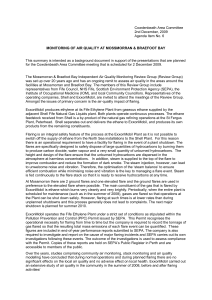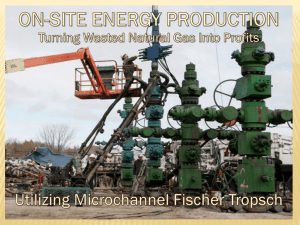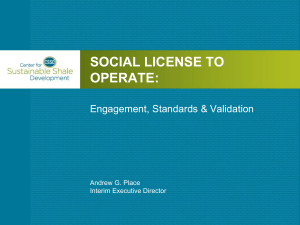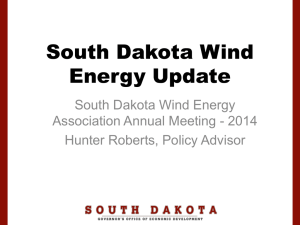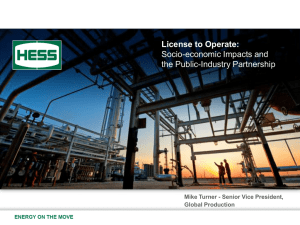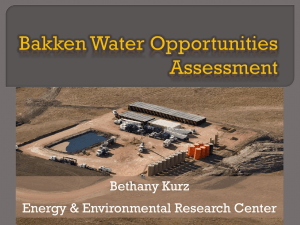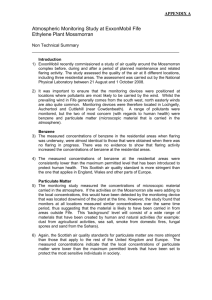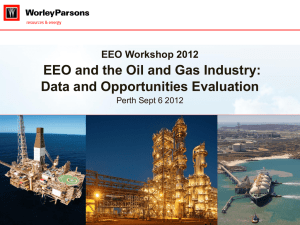View Abstract - United States Association for Energy Economics
advertisement
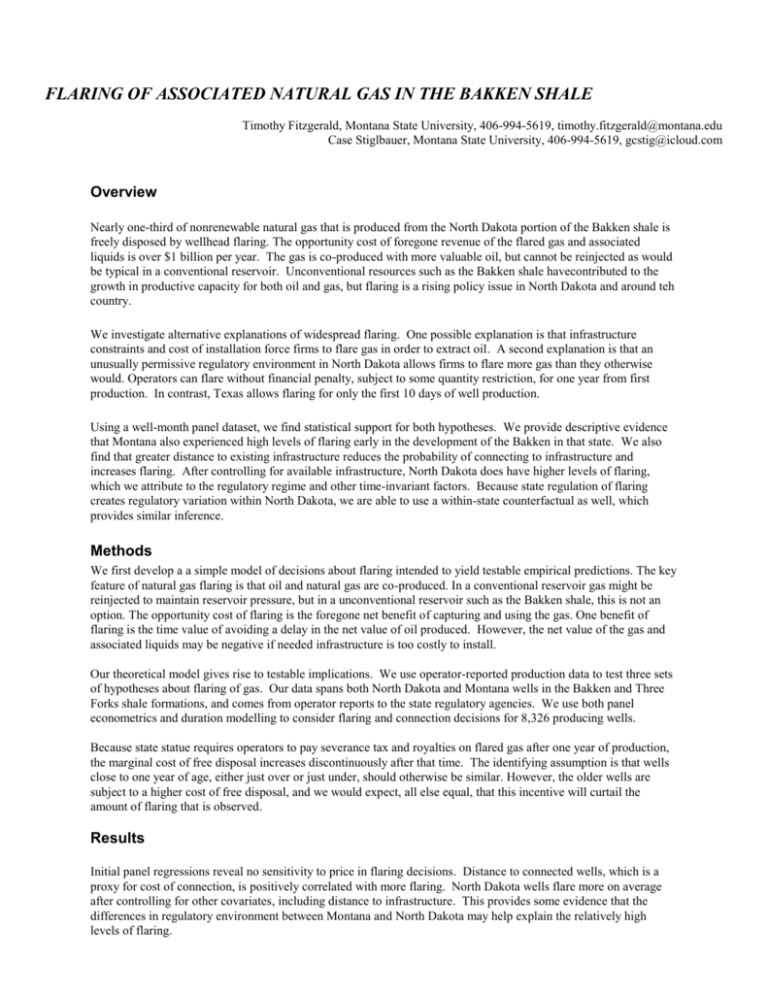
FLARING OF ASSOCIATED NATURAL GAS IN THE BAKKEN SHALE Timothy Fitzgerald, Montana State University, 406-994-5619, timothy.fitzgerald@montana.edu Case Stiglbauer, Montana State University, 406-994-5619, gcstig@icloud.com Overview Nearly one-third of nonrenewable natural gas that is produced from the North Dakota portion of the Bakken shale is freely disposed by wellhead flaring. The opportunity cost of foregone revenue of the flared gas and associated liquids is over $1 billion per year. The gas is co-produced with more valuable oil, but cannot be reinjected as would be typical in a conventional reservoir. Unconventional resources such as the Bakken shale havecontributed to the growth in productive capacity for both oil and gas, but flaring is a rising policy issue in North Dakota and around teh country. We investigate alternative explanations of widespread flaring. One possible explanation is that infrastructure constraints and cost of installation force firms to flare gas in order to extract oil. A second explanation is that an unusually permissive regulatory environment in North Dakota allows firms to flare more gas than they otherwise would. Operators can flare without financial penalty, subject to some quantity restriction, for one year from first production. In contrast, Texas allows flaring for only the first 10 days of well production. Using a well-month panel dataset, we find statistical support for both hypotheses. We provide descriptive evidence that Montana also experienced high levels of flaring early in the development of the Bakken in that state. We also find that greater distance to existing infrastructure reduces the probability of connecting to infrastructure and increases flaring. After controlling for available infrastructure, North Dakota does have higher levels of flaring, which we attribute to the regulatory regime and other time-invariant factors. Because state regulation of flaring creates regulatory variation within North Dakota, we are able to use a within-state counterfactual as well, which provides similar inference. Methods We first develop a a simple model of decisions about flaring intended to yield testable empirical predictions. The key feature of natural gas flaring is that oil and natural gas are co-produced. In a conventional reservoir gas might be reinjected to maintain reservoir pressure, but in a unconventional reservoir such as the Bakken shale, this is not an option. The opportunity cost of flaring is the foregone net benefit of capturing and using the gas. One benefit of flaring is the time value of avoiding a delay in the net value of oil produced. However, the net value of the gas and associated liquids may be negative if needed infrastructure is too costly to install. Our theoretical model gives rise to testable implications. We use operator-reported production data to test three sets of hypotheses about flaring of gas. Our data spans both North Dakota and Montana wells in the Bakken and Three Forks shale formations, and comes from operator reports to the state regulatory agencies. We use both panel econometrics and duration modelling to consider flaring and connection decisions for 8,326 producing wells. Because state statue requires operators to pay severance tax and royalties on flared gas after one year of production, the marginal cost of free disposal increases discontinuously after that time. The identifying assumption is that wells close to one year of age, either just over or just under, should otherwise be similar. However, the older wells are subject to a higher cost of free disposal, and we would expect, all else equal, that this incentive will curtail the amount of flaring that is observed. Results Initial panel regressions reveal no sensitivity to price in flaring decisions. Distance to connected wells, which is a proxy for cost of connection, is positively correlated with more flaring. North Dakota wells flare more on average after controlling for other covariates, including distance to infrastructure. This provides some evidence that the differences in regulatory environment between Montana and North Dakota may help explain the relatively high levels of flaring. Preliminary results of a Weibull-distributed hazard of connection to infrastructure for North Dakota wells are reported inindicate that higher dry gas prices increase the probability of connection. Raw gas prices have a similar effect, which suggests that keep whole contracts are likely to prevail in the Bakken region. If raw gas had a greater effect than dry gas, then we would conclude that share contracts allow operators to benefit from the NGL premium. The probability of connection decreases with the number of producing months. This result suggests that wells with good prospects are connected fairly early in their life, and some wells are never connected. This provides a different inference than the idea that all wells will eventually be connected. We find evidence of heterogeneity across operators, which recommends further study of contracts. Variation in field rules allows a separate empirical test using only wells within North Dakota. Exploratory regressions of the field rule data indicate that regulatory compliance is heterogeneous across operators, with the smallest operators the most likely to comply with field rules for flaring. More stringent rules are less likely to be violated than more common, lenient rules. Empirical work on this section is ongoing. Conclusions To our knowledge this is the first comprehensive study of the economics of natural gas flaring and attendant infrastructure investments. We find evidence that infrastructure costs are an important determinant in flaring, that product prices do not affet decisions to flare or connect to infrastructure, and that the relatively loose regulatory model in North Dakota permits more flaring than in Montana. These results have implications for policy in North Dakota and beyond. In North Dakota, state regulators have imposed new regulations requiring operators to plan for gas capture at the time new wells are permitted. Other unconventional resource plays, notably the Eagle Ford shale in Texas, have also experienced dramatic increases in gas flaring. However, in other areas the proportion of natural gas captured and marketed is far higher than in North Dakota. As flaring becomes a national policy issue due to review by Bureau of Land Management managers overssing federally-owned minerals, the lessons of the Bakken are likely to be front and center in understanding how to make optimal investments in gathering and processing capcity. References Bahadori, Alireza, Natural Gas Processing: Technology and Engineering Design, Gulf Professional Publishing, 2014. Burt, Oscar R. and R.G. Cummings, “Production and Investment in Natural Resource Industries," American Economic Review, 1970, 60 (4), 576-590. Hausman, Catherine and Ryan Kellogg, “Welfare and Distributional Implications of Shale Gas," Working Paper 21115, National Bureau of Economic Research, April 2015. Klein, Benjamin, Robert G. Crawford, and Armen A. Alchian, “Vertical Integration, Appropriable Rents, and the Competitive Contracting Process," Journal of Law and Economics, 1978, 21 (2), 297-326. Kuller, Robert G. and Ronald G. Cummings, “An Economic Model of Production and Investment for Petroleum Reservoirs," American Economic Review, March 1974, 64 (1), 66-79. Oliver, Matthew, Charles F. Mason, and David Finnoff, “Pipeline Congestion and Natural Gas Basis Differentials: Theory and Evidence," Journal of Regulatory Economics, December 2014, 46 (3), 261-291. Stiglbauer, Gordon, “North Dakota Associated Natural Gas: The Decision to Flare," M.S. Thesis, Montana State University, Bozeman, MT, 2015.
